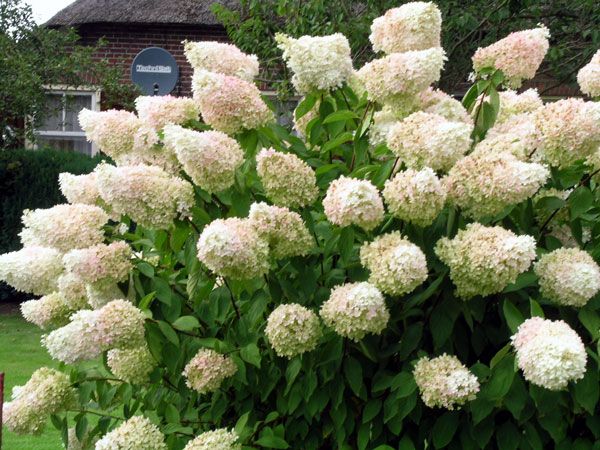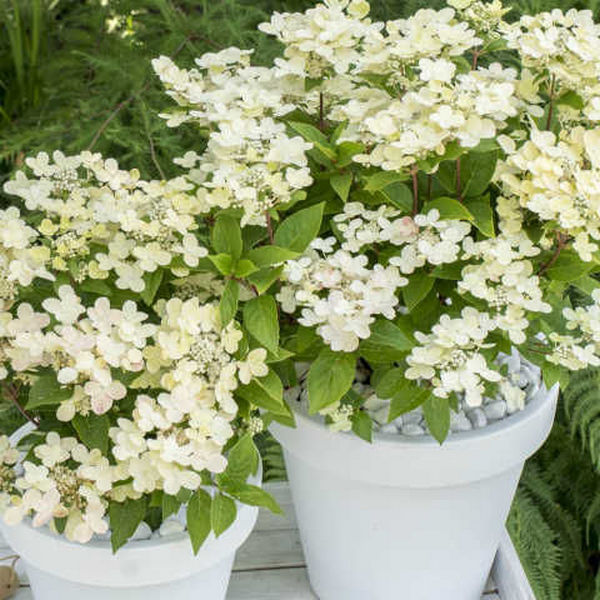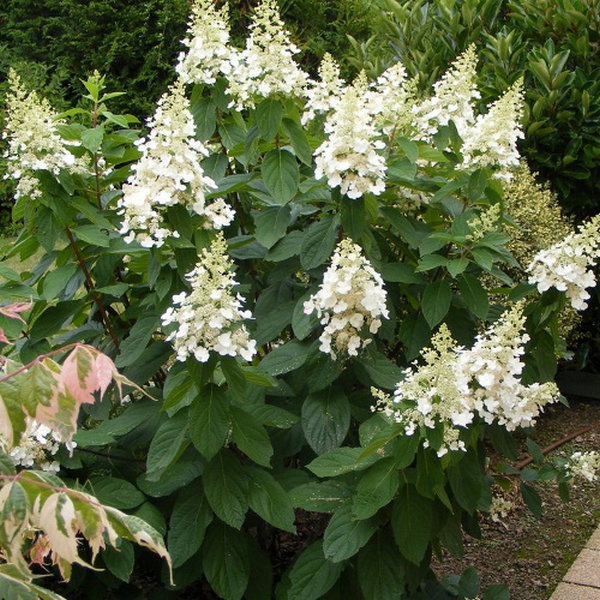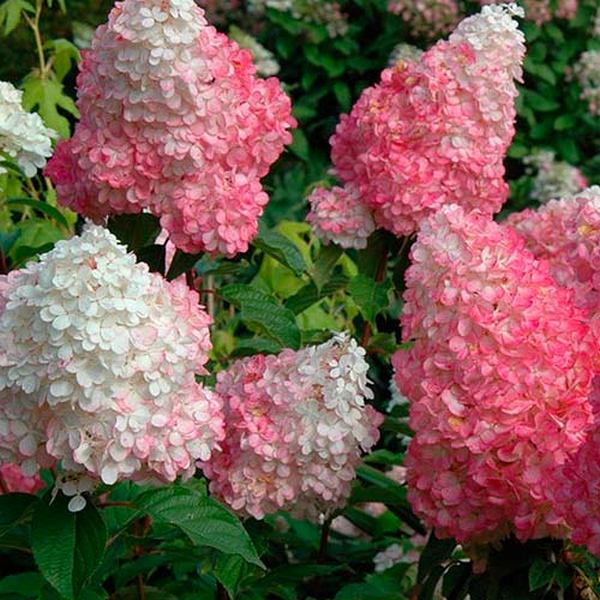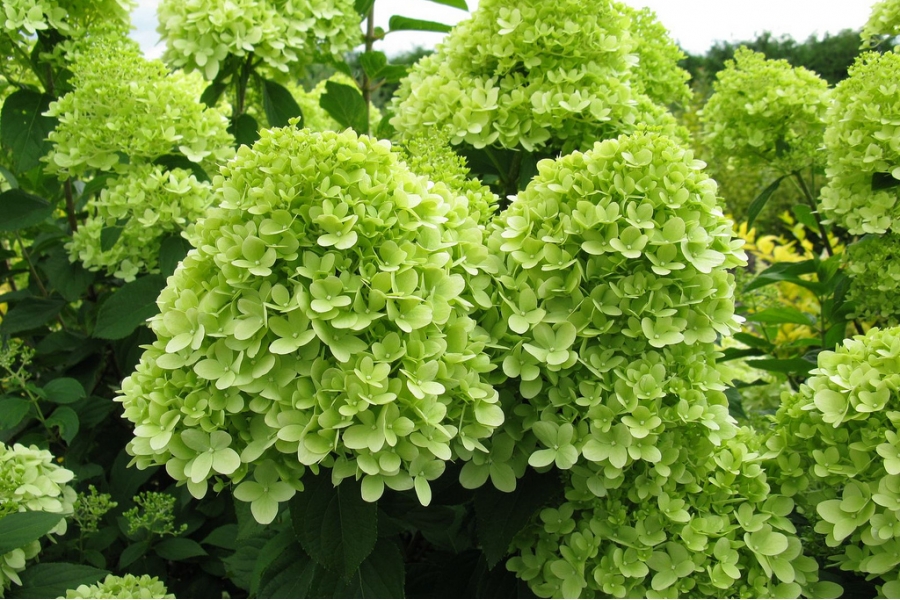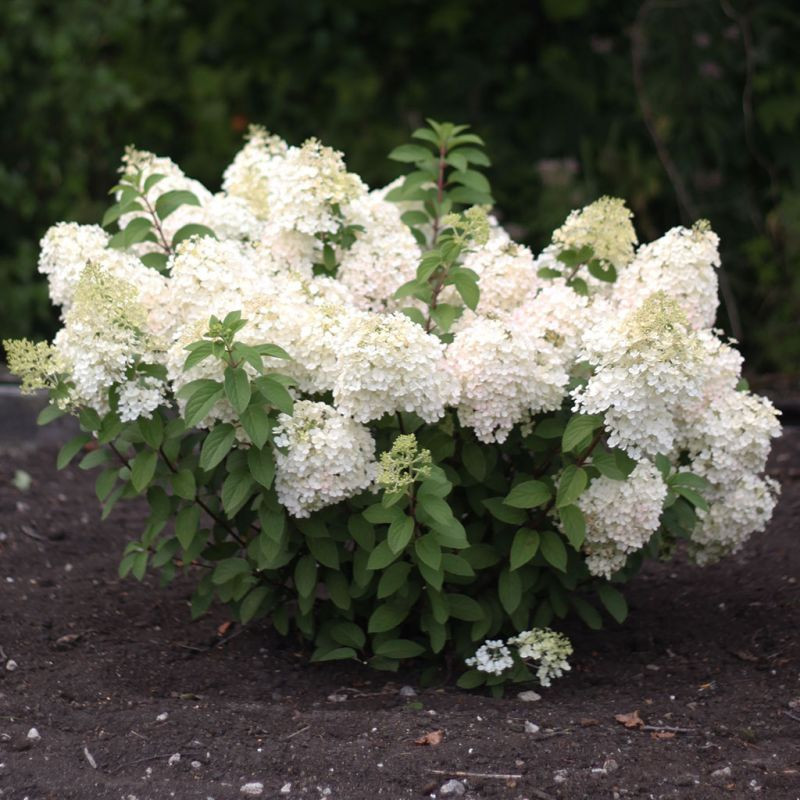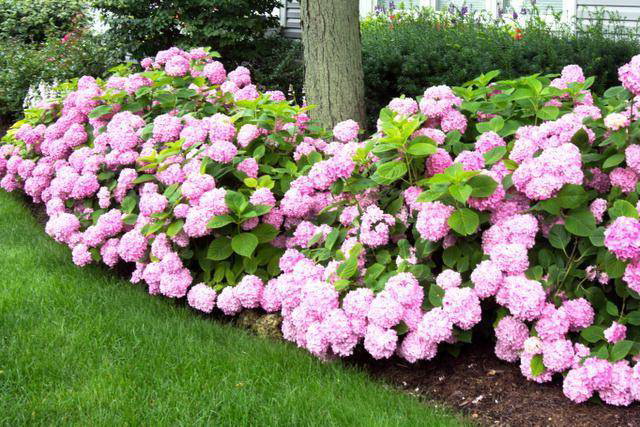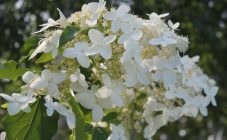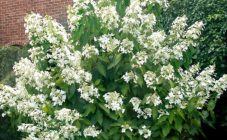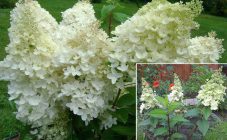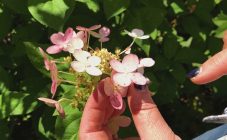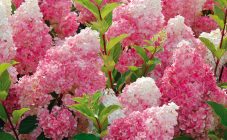Content:
The airiness and tenderness of panicle hydrangea inflorescences have long conquered gardeners. Due to the unpretentiousness and ease of forming a bush, it serves as an ideal decoration for any site. The status of the queen of the garden received the panicle hydrangea, its varieties amaze with their diversity and exquisite beauty.
Description
Hydrangea paniculata, the name in Latin - Hydrangea paniculata, is a small tree or shrub, up to 10 m high. In Greek, the name of the flower means "a vessel with water", speaking of the main condition for the growth of a plant.
The plant has a long flowering time - from mid-June to October. Its unblown inflorescences look like round small buds and resemble a scattering of beads. The blossoming honey-bearing inflorescences bend the branches with their weight, making the crown round. The snow-white flowers gradually take on a pinkish tint around the edges, reaching a pink-purple color. Fertile flowers are small, white petals. Infertile flowers are larger, consisting of 4 petals, white to pink.
Hydrangea Panikulata is distinguished by its rapid growth, frost resistance. It is a moisture-loving plant that grows well along water bodies. The species is common in the central and northern part of Russia.
Varieties
The panicle hydrangea is famous for a huge number of different flowers, the best varieties are invented every year by the efforts of breeders. The oldest, respected varieties: Grandiflora, Matilda, Brussels Leis, Floribunda, Pink Diamond, Kiushu, Tardiva, Unique.
Hydrangea paniculate - new varieties of recent years: Bobo, Dolly, Great Star, Darts Little Dot, Diamond Rouge, Little Lime, Limelight, Magic Fire, Pinky Winky, Silver Dollar, Vanilla Fraz, Sunday Fraze, Fraze Melba, Baby Lace.
Grandiflora
It is a widespread variety. Massive shrub, about 2 m high, is recognized as the leader in the growth and size of inflorescences. The panicles are large, reaching 30 cm. The shape of the inflorescences is pyramidal, composed of sterile flowers. The color is initially creamy white, then turns pink, becoming greenish-red in autumn. Bloom lasts from July to September.
Dark green leaves have an oblong shape with a pointed tip and a slightly velvety texture. They differ in later blooming. The Grandiflora variety is quite light-requiring, but it can also tolerate partial shade. A young plant can freeze over in severe frosts, but as it matures, its winter hardiness increases. An adult bush can withstand temperatures down to -25 degrees The soil should be fertile, loose, moist, acidic. Lime in the soil is detrimental to the plant.
Mega Pearl
Hydrangea Mega Pearl is represented by a rather spreading bush reaching 2.5 meters in height. The inflorescences are conical, large (about 30 cm), fragrant. They are composed of small fertile flowers surrounded in a spiral with large sterile flowers.The color changes from greenish-white at the beginning of the flowering process to creamy white in the middle and pinkish-red by autumn. The variety requires loose, mineral-rich, moderately moist soils. The place should be well lit, a little shade is allowed. Bloom lasts from July to September.
The variety is characterized by frost resistance, good heat tolerance, subject to regular watering and pruning. The plant is almost not susceptible to diseases and pests.
Hydrangea Polistar (Polestar)
Hydrangea Polistar is ultra-compact, as it reaches a size of only 50-60 cm. The compact variety serves as a wonderful decoration for balconies and terraces. Inflorescences change their shade from pistachio to dark pink. Blooms profusely from late June to September. Hydrangea Polestar is winter-hardy, withstands temperatures up to -23 degrees. It is advisable to choose a place that is well lit or slightly shady. The soil needs to be moist, well-drained.
Hydrangea White Goliath
Hydrangea Goliath is a powerful shrub that grows up to 3 m. Large white inflorescences of a narrow conical shape eventually change color to pale pink. It is a late flowering variety that blooms from late July to September. The plant requires fertile, acidic soil, but it can grow on any other type of soil. The leaves have a large, broadly lanceolate shape and a pointed end. Emerald green leaves are beautifully combined with burgundy petioles. The variety thrives both in open areas and in partial shade. Winter hardy, so no shelter is required.
Hydrangea Kyushu
Hydrangea Kiushu is a 3-meter shrub with a round, dense crown. The variety is suitable for growing in the middle lane and in the Urals. The flowering period lasts from the second half of summer (July) to late autumn (mid-October), which indicates its high frost resistance. The plant belongs to long-livers, there are bushes at the age of 60 years.
Leaves are glossy, located on red petioles. Turn yellow in autumn. The leaf plate is ovoid, reaching a length of 12 cm. There is a small edge on the upper side of the leaf and a stronger one on the lower side. Inflorescences are represented by long wide-pyramidal panicles, reaching 25 cm in length. Fertile white flowers outnumber sterile ones. The variety loves clay, acidic soils. Prefers moderately lit areas, withstands partial shade, is able to withstand prolonged stagnation of moisture.
Hydrangea Vanilla Fraise
The variety is represented by a large bush. The height of the hydrangea is about 2 m. The leaves are simple, oblong, velvety, have a dark green color. Hydrangea blooms from early July to late October and begins in the first year. The inflorescences are very large, about 40 cm long, up to 30 cm in diameter.
The flowers that have just blossomed are white, and a beautiful pinkish edging appears as they grow. Then the flowers turn crimson, resembling vanilla ice cream with strawberry syrup. The inflorescence itself is initially white, then becomes a two-tone color with a white top. At the end of flowering, a red tint remains.
The plant needs bright lighting, wind protection, good watering. The variety grows well in the Moscow region. Due to frost resistance, it can withstand the climate of Siberia and the Urals. The variety is able to withstand temperatures from -30 to -40 degrees. The plant is considered a long-liver, as it lives up to 40 years.
Hydrangea Limelight
Limelight is a Dutch variety, about 2 m high. Its distinctive feature is that the bush does not require props. Strong shoots hold large inflorescences well, retaining the shape of a wide-round crown. The leaves are wide, greenish-purple, slightly velvety. The size of the cone-shaped inflorescences reaches 25-30 cm and is almost entirely composed of sterile flowers. The color of flowers is greenish at first, then turns white, and after flowering - pink.The color also depends on the lighting.
Flowering lasts from July to September. Hydrangea Limelight loves slightly acidic or acidic soils. There should be no lime in the soil. The soil should be sufficiently moist, but without stagnant water. It is advisable to choose a shaded area as direct sunlight will harm it. The variety is winter-hardy, this property improves with age. Hydrangea Limelight is well suited for growing in the Leningrad region.
Hydrangea Bobo (Bobo)
This is one of the new varieties of panicle hydrangea, a dwarf form. The bush is very compact. The height of the plant is no more than 60-70 cm, and the width is 50 cm. The leaves are dark, green. Dense conical inflorescences are collected from flowers that change color from lemon yellow to white and pale pink. The undersized bush blooms very profusely from late July to September.
Hydrangea Bobo loves partial shade. The soil should be acidic, moist, fertile. For the winter, it is necessary to cover and mulch the root system. Bobo has won the Florall award in Belgium as the best novelty among panicle hydrangea varieties. It is designed for small garden plots, narrow flower beds, borders, terraces.
Features of agricultural technology
Varietal seeds, seedlings must be purchased in garden centers and nurseries. When buying seedlings, do not believe too much in the description and photo on the label. It is better to buy where you can see the variety during flowering.
The timing of the start of planting depends on the area. If the climate is warm, then you can plant the plant in the fall so that it has time to take root. For the middle zone and cold regions of Russia, the best planting time is spring, after the last frosts.
You need to plant plants in a lighted place, but without direct sunlight at noon. In hot times of the day, it is better to provide him with partial shade. The soils should be loamy, well-drained with an acidic or neutral environment. Alkaline soils are harmful to hydrangeas.
Planting hydrangea seedlings in open ground is carried out before bud tying begins. A prepared fossa, 30-50 cm in size, is filled with a mixture of manure and bone meal. You can buy a special hydrangea feed. They also use peat, sand, mineral and organic fertilizers. It is recommended to add a liquid hydrogel to the well to retain moisture.
The seedling, together with the earthen lump, is placed in the hole so that the root collar does not go deeper than the soil surface, but is level with it. The seedling is buried, the soil is well compacted to avoid the formation of voids between the roots and the ground. Then the plant is watered abundantly and mulched by 5 cm with a layer of peat and humus. For spring planting, it is necessary to cut off annual shoots by 3-4 buds.
Care
Panicle hydrangea is a moisture-loving plant, so watering should be abundant and frequent. To prevent the soil from drying out in the heat, you can add moss or hydrogel to the root system when planting. It is important to properly feed the plant. In the first year after planting, it can be left without additional fertilization. Further feeding is carried out three times a year:
- In early spring, as soon as shoots appear, a complex mineral fertilizer is required.
- At the beginning of budding (mid-June), a mixture of superphosphate and potassium sulfide is made in a ratio of 7: 4. The mixture (100 g) is dissolved in a bucket of water and the plant is watered.
- Mullein is introduced in the last days of summer. Manure is mixed with water in a ratio of 1: 3, infused for a week. For irrigation, an aqueous solution of the resulting fertilizer is used in a ratio of 1:10.
As soon as the plant begins to fade, it is recommended to add potassium salt.
Hydrangea is frost-resistant, so in most cases there is no need to worry about covering for the winter. But in regions with severe winters, it is worth spilling and covering the root system with mulch. If the temperature drops below -35 degrees, then the bushes must be tied up and covered with lutrasil or spunbond. A frame is built outside, the cavity of which is filled with straw or dried foliage. Young bushes are pressed to the ground with roofing material, boards and bricks.
Advantages and disadvantages
Panicle hydrangea has many benefits:
- a variety of exquisite varieties and varieties for every taste;
- high degree of resistance to low temperatures, which increases with age;
- grows quickly and begins to bloom already 3-4 years after planting;
- abundant and lush bloom;
- can be grown as a shrub or as a standard tree;
- can grow even in shady areas of the garden.
Hydrangea seedlings are inexpensive, the plant reproduces easily. When planting several different varieties of panicle hydrangea at once, moderation should be observed, since the garden turns out to be very bright. To see all the beauty of the inflorescences, you can first organize a seedling bed. For the next season, you can distribute them according to the color or shape of the inflorescences and transplant, in accordance with the style of the garden. Transplanting in the early years is well tolerated by the plant.

